
On Thursday evening of the COMSOL Conference 2013 Boston, winners of the top papers and posters were presented with their awards. Reading through their papers and posters, I noticed a common theme: they all included experimental validation of their simulation results. While modeling provides crucial insight and understanding, as well as the opportunity to design and optimize your applications and processes, its credibility often depends on whether results test well against known results. The award winners at the multiphysics conference in Boston clearly indicated that such validation is important.
Congratulations to the Award Winners of the COMSOL Conference 2013 Boston
[thethe-image-slider name=”BostonPaperPosterWinners2013″]
Coupling Physics Reigns Supreme for Best Paper Winners
The first Best Paper winner to receive his award was Ranjeeth Naik from Michigan Technological University. Naik presented his research on condensing flows in a channel, and when the flow transfers from the annular to the non-annular regime. Annular flow occurs in gas-liquid flow when a liquid film is formed along the channel wall, surrounding the gas. Its existence or nonexistence has a significant effect on heat transfer to and from the system, while parameters such as flow rate and gravity affect it greatly. It is an important variable in systems relating to boiling, condensation, and heat exchange. As they are difficult to measure on a case-by-case basis, they benefit greatly from modeling.
Seunghee Kim from The University of Texas at Austin presented work explaining unexpected results that were originally found through experiment. CO2 sequestration is being investigated at a mine site in Mississippi and measurements indicate that higher pressures are occurring in a zone way above where the CO2 is injected. This would initially indicate that the CO2 is leaking from the sequestration zone, but Kim showed through simulation that these increased pressures occur through geomechanical effects instead, originating from the CO2 flow in the injection zone.
The third Best Paper winner also coupled structural mechanics to another physics — this time chemical reaction kinetics and material transport. Kamlesh Suthar of Argonne National Laboratory provided great understanding to the swelling characteristics of hydrogels, which can increase to up to four times their size, as a function of their pH. He was able to couple the participating physics together with the Arbitrary Lagrangian-Eulerian (ALE) method for moving mesh and predict the eventual shape of the hydrogel at a certain pH.
Food Engineering Predominates in Best Poster Submissions
Alexander Warning from Cornell University was the first Best Poster winner brought up on stage for his work on modeling material transport and the sublimation front in porous media, which occurs in applications like freeze drying. The Popular Choice vote for Best Poster also had connections to food engineering, as Jihan Cepeda of the University of Nebraska-Lincoln presented her research on the simulation of air-cooling of a chicken carcass. Conference attendees voted for Cepeda’s poster, as she was able to show how the image from a CT-scanned chicken carcass can be included in COMSOL Multiphysics to produce both the model geometry and material properties. The final winner of the Best Poster award was Wen-Hsuan Lee from MIT, who was able to couple the physics from microwave heating to heat transfer and fluid flow through a microreactor. The reason for doing this is to control the reaction’s kinetics and increase through-put.
All-in-all, over 100 papers and 70 posters were presented at the COMSOL Conference 2013 Boston, which is a record for the number of submissions. All of them were worthy of recognition, but the winners featured here were particularly commendable. I’m certainly looking forward to next year and the interesting contributions that will be presented then.



Comments (0)